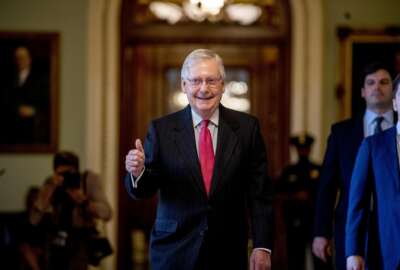
Breaking down the largest spending bill ever
God created the world in six days, about how long it took Congress to craft the biggest spending bill since the big bang.
Best listening experience is on Chrome, Firefox or Safari. Subscribe to Federal Drive’s daily audio interviews on Apple Podcasts or PodcastOne.
God created the world in six days, about how long it took Congress to craft the biggest spending bill since the big bang. To find out what’s in it for federal agencies, Federal Drive with Tom Temin spoke to Bloomberg Government Editorial Director Loren Duggan.
Interview transcript:
Tom Temin: I don’t know where to begin, so I’m gonna let you decide.
Loren Duggan: Sure, well, you know the total price tag of this thing is north of $2 trillion, which is one of the biggest pieces of legislation dollar wise that anyone has ever seen. Even if you look back at the stimulus plan after the financial crisis when President Obama came to office, that was only in the $787 billion range. So this is much larger. The money that adds up to that two trillion comes in a lot of different forms. Some of it’s the tax provisions, some of it mandatory spending that will go out over time through the unemployment insurance, or through some of the loan packages that are there. But there is a supplemental appropriations package put together by Richard Shelby, his cardinals and other people on the appropriations panel that will spend about $340 billion across different agencies to try and get that money first to the agencies and then out to the country. As he’s put it about 80% or so of the money there is meant for state and local government. So if you look at that pool of money, which is you know something, we’re familiar with the normal spending process. This large infusion of cash on top of that is a pretty significant.
Tom Temin: It is significant. And I guess the biggest shares go to Veterans Affairs and the Defense Department and HHS, from what I can tell.
Loren Duggan: Right the biggest is HHS, which makes sense. This is primarily a health emergency, and so the mechanism set up a HHS to take money and send it out to the state is already there and established, so they’re taking advantage of that. 100 billion of it, I believe, is just to help healthcare providers and send that money out. But you mentioned some of the other departments that get pretty big allocations. One is Homeland Security, and that’s mostly because FEMA is there and there’s the disaster relief fund, that’ll get about $45 billion as a result of this bill. If you look out the other agencies, DoD does get $10.5 billion with maybe about 1/3 or even more for the Defense Health Program and for paying through other care related to health. So that’s a pretty big chunk. And then the Veterans Affairs Department gets somewhere between $19.5 and $20 billion. So another pretty healthy infusion of cash into that department as it tries to help the population it serves as the virus continues to spread around the country.
Tom Temin: Yeah, there’s some big numbers, but also some big unknowns, I guess for, say, FEMA. You know there’s no flooded zones. There’s no tracts of houses that are flattened by hurricanes or tornadoes. You can’t see this thing. And also we’re just getting toward the, you know, the season where bad weather can happen. So I guess FEMA is probably the one that maybe is the biggest question mark as to what it’ll actually need.
Loren Duggan: It is, But it also has good experience of going out into the country and helping with emergency situations, often not in the best of conditions, and part of its role is to help prepare. And I think that’s what some of this money will go to, as well as helping some cities and towns and elsewhere around the country get prepared in case the virus does spread to them and spread in, you know, some of the numbers we’ve seen elsewhere around the world, and even that we’re beginning to see in New York City as health care systems get stretched thin so we we could see FEMA play a big role here. I mean, there are many types of disasters they help with man made, when a terrorist attack obviously, or with natural disaster. So this is a natural caused disaster, but one that FEMA will draw on its resources and experiences to help around the country.
Tom Temin: And as you mentioned, there’s a lot of channels of money, direct payments to Americans making certain income levels, and also to the corporate world. And within the corporate world, there is the whole small business channel. What do we know about that one?
Loren Duggan: Right? There are pretty big pools of money here. There’s the $500 billion pool that’s meant for larger businesses, in particular the airlines, national security businesses, which most people think will help send cash out to Boeing. And then other businesses that the officials handing out this money believe are in need of it. There is a separate pool here. I think it’s around $349-350 billion to provide assistance to smaller firms around the country. And those could be loans that they can tap into their lower, no interest. In some cases, I know they’re looking at ways to just make those grants, if ever they can to try and help business is one of the goal here is to get businesses to keep workers on the books, to not let them go or not furlough them. But when that does happen, if it does happen, there is also an infusion here into the unemployment insurance program that would provide extra benefits to people for several months. So you know, they’re trying to keep people on the books, but there is this kind of safety valves, and then you also mentioned the payments to individuals who make up to a certain amount of income. The payments could be up to $1200 for individual and then $500 for children, which it’s a one time thing. Income caps but would be an immediate infusion of cash. So there’s lots to help people there, not to mention the food aid that’s there people do need to draw on the Supplemental Nutrition Assistance Program or some of the child nutrition programs that are also funded here.
Tom Temin: And do you feel or does it look at this point whether all of this work will have some effect or some distortion on the regular appropriations process that, in theory is supposed to be going on for fiscal 2021?
Loren Duggan: Definitely. I mean the one thing that people aren’t just gonna be here, and you need to be in town sometimes to meet face to face and have the initial conversations on those sorts of bills. We’ve already seen the hearing schedule get disrupted the last couple of weeks. One thing that they’re turning to is so called paper hearings for virtual hearings, where instead of convening people in a room, which obviously is frowned upon now they’ll pass paper around or take testimony and try and create a record that way to help make writing the bills easier. And that affects not just the 12 corporations bills, but obviously something like the National Defense Authorization Act that’s an annual process. So we see committee’s trying to shift their way of doing business because they do want to try to make progress on this when they do return. Right now, it looks like end of April or late April. They want to hit the ground running, but obviously they have to see what the conditions are in their home states and here in Washington, D. C. before they make the actual call on what to come back and want to do. But that’s the target for right now.
Tom Temin: Yes, because the big bill was number three in the series of bills going back a month or so now, and the House speaker, Nancy Pelosi, and other members have hinted at fourth bill related to coronavirus. Do we know anything about that at this point?
Loren Duggan: Well, there’s been some talk about it already, and Nancy Pelosi gave some interviews Thursday, which was her 80th birthday, by the way, and she was out making the rounds, and she’s talked about the fourth phase being more about recovery potentially than these early stages, which were about preparing, trying to get money out to the states quickly and then helping people who have lost their jobs or who are risk of losing their job. So some of the things she’s talked about looking at, although there’s money here for supplemental nutrition assistance programs, she’s talked about maybe expanding the benefit so that each person who gets SNAP money would get a little bit more. She’s looking at some pension relief legislation that have been a goal even before the coronavirus, something that House has been trying to enact for a while. They’re looking at using potential fourth bill to advance that. One of the things close to home here is that in one of the pools of money, D.C. was lumped in with territories rather than states and in a lot of federal allocations of money, D. C is treated at state. So she wants to try to address that. And then something that she and Richard Shelby have also been talking about a lot., our infrastructure programs. There is a major bill, the Highway Transit Authorization bill expires September 30th. That was on Congress’s to do list as well as other infrastructure activity, so we could see another look at that as part of a phase four bill, if you will. And then Mike Pence has said that he’s going to continue to listen to governors and local officials across the country and see if they need more money. And that could obviously be part of any phase four. And if there’s some sort of issue with this bill, that sometimes happens, you know they try to write them very carefully, but sometimes when you get around to implementing these bills, you find that there’s a quirk or a nuance that had been missed when you were drafting it, so if they needed to address anything like that, that could obviously be part of phase four as well.
Tom Temin: Loren Duggan, is the editorial director of Bloomberg Government. Thanks so much.
Loren Duggan: Thank you.
Copyright © 2024 Federal News Network. All rights reserved. This website is not intended for users located within the European Economic Area.




